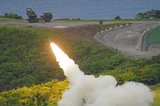South Korea announces hike in payment for US troops
Seoul said on 10 February that it agreed to hike its payment for maintaining US troops on its soil, settling a dispute with its long-time ally ahead of a second summit between the US and North Korea.
The two countries have been in a security alliance since the 1950-53 Korean war, which ended with an armistice rather than a peace treaty - with more than 28,000 US troops stationed in the South to guard against threats from Pyongyang.
But US President Donald Trump has repeatedly complained about the expense of keeping American forces on the peninsula, with Washington reportedly asking Seoul to double its contribution toward costs. The negotiations ended with South Korea's foreign ministry saying Seoul will pay about ₩1.04 trillion ($924 million) in 2019, 8.2 percent more than what it offered under a previous five-year pact which expired at the end of last year.
The ministry said that although the US had demanded a ‘huge increase’ in payment, they were able to reach an agreement that reflects ‘the security situation of the Korean peninsula’.
‘The two countries reaffirmed... the importance of a strong South Korea-US alliance and the need for a stable stationing of the US troops,’ it said in a statement issued after a signing ceremony.
The row had raised concern that Trump may use it as an excuse for US withdrawal. The US president and North Korean leader Kim Jong Un are expected to discuss an official declaration to end the decades-old war - a prelude to a peace treaty - at their second summit in Hanoi later in February.
At their first meeting in Singapore last year, the notoriously unpredictable US president had made a shock decision to suspend US-South Korea military drills. But Trump told US broadcaster CBS last week that he had ‘no plans’ to remove US troops from South Korea as part of a deal at the upcoming summit, although he admitted ‘maybe someday’ he would withdraw them, adding: ‘It's very expensive to keep troops there.’
Since the deal is only valid for one year, the two sides may soon have to return to the negotiating table.
Seoul contributed around ₩960 billion last year - more than 40% of the total bill - financing the construction of American military facilities and paying South Korean civilians working on US bases.
The deal will officially go into effect after it receives parliamentary approval in South Korea, which is expected to take place in April, according to Yonhap news agency.
More from Defence Notes
-
![How might European countries look to tackle drone incursions?]()
How might European countries look to tackle drone incursions?
Disruption of infrastructure in Europe, whether by cyberattack, physical damage to pipelines or uncrewed aerial vehicles flying over major airports, as has happened more recently, is on the rise. What is the most effective way of countering the aerial aspect of this not-so-open warfare?
-
![Taiwan approved for $11 billion weapon purchase from US]()
Taiwan approved for $11 billion weapon purchase from US
The US State Department’s approval of a multi-billion-dollar sale of weapons to Taiwan includes tactical mission networks equipment, uncrewed aerial systems, artillery rocket systems and self-propelled howitzers as well as anti-tank guided missiles.
-
![US National Security Strategy prioritises advanced military capabilities and national industry]()
US National Security Strategy prioritises advanced military capabilities and national industry
The 2025 NSS has emphasised investment in the US nuclear and air defence inventory and national industry, but it leaves multiple unanswered questions on how the White House will implement this approach.
-
![Canada set to look away from its neighbour and across the Atlantic for partners]()
Canada set to look away from its neighbour and across the Atlantic for partners
While non-EU UK struggles to join the Security Action for Europe initiative, which provides loans for defence programmes, Canada has become the first country outside Europe to get access – and did so for a nominal fee.
























